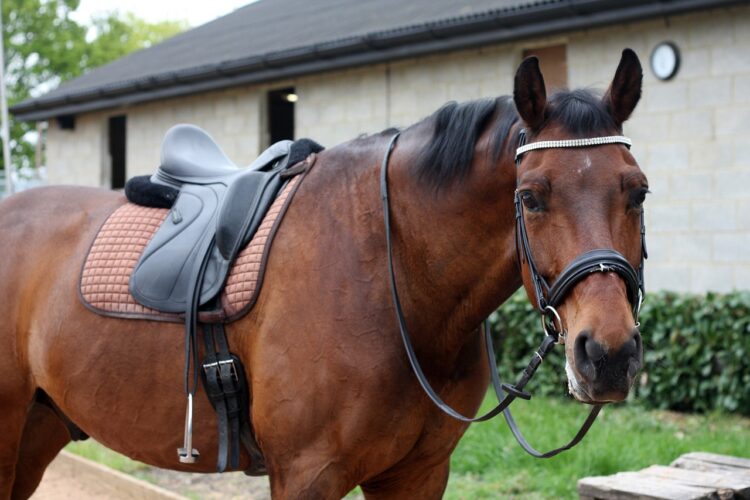Guest post courtesy of Jane Savoie. The views and opinions expressed in this article are those of the guest author and do not necessarily represent the views of Val Heart & Heart Communication Enterprises Inc.
This month I’ll explain how to use the “Connecting Aids” with a lazy horse to put him on the bit. Next month, I’ll talk about connecting the hot Horse.
Here’s a review of the connecting aids:
(1) Close both calves to generate power from behind.
(2) Close your outside hand in a fist to capture, contain, and recycle that power back to the hind legs.
(3) Squeeze and release (vibrate) the inside rein, like squeezing water out of a sponge, to keep your horse’s neck straight.
Apply the three sets of aids for approximately three seconds. To an observer, it will appear that you’re giving the aids simultaneously, but in reality the legs slightly precede the closing of the outside hand, which is applied just before the vibrations with the inside hand.
In order to get the desired effect from these connecting aids, it’s important that your horse responds obediently to your aids. This is often overlooked, as many of us have a very lazy horse that seems to ignore our aids. Here are some tips to help you.
The Lazy Horse
Your connecting aids won’t work if your horse isn’t in front of your driving aids. For example, when you put your legs on, your horse should immediately move forward. Remember that horses are extremely sensitive to touch. No matter how lazy a horse is, he can feel a fly land on his side and flick it off.
It’s usually the rider who makes the horse dull. The horse isn’t electric enough, so the rider uses more leg. That works for a while, but then the horse gets dull to that, so the rider starts putting on spurs. Then the horse gets used to that so the spurs get bigger. This cycle is common, and as time goes by, the leg aid gets louder and louder.
The reason your horse isn’t reacting to light aids is probably because you’ve started “screaming” with your aids, and he’s tuned you out.
The first thing you have to do is decide that you’re not going to close your legs any stronger than a fly landing on your horse’s side. When you whisper with an aid, your horse should shout his answer – instead of the other way around.

The Correction
Instead of constantly repeating your aid or making it stronger, make a correction. The correction for the lazy horse depends on his sensitivity. You can either bump-bump-bump with your legs, or you can use your whip and tap-tap-tap to chase your horse forward.
Either way, you need to get a really forward response. If you’re walking, bump or tap until your horse is trotting; if you’re trotting, do it until he breaks into the canter.
The most important part of the correction is to re-test with a light, whispering aid. For example, in a transition from walk to trot, lightly close your legs, and your horse should surge into the trot. If he doesn’t, tap-tap-tap, but then you must go back to the walk and re-test with a very light aid for that transition. When he reacts enthusiastically, praise him.
Once he’s in front of your leg, go back to using the connecting aids as described above.
Reprinted with permission.
About Jane Savoie: Jane Savoie is one of the most recognized names in dressage, and for a good reason. She has been a member of the United States Equestrian Team and has competed for the US in Canada, Holland, Belgium, France and Germany. She was the reserve rider for the Bronze medal winning Olympic dressage team in Barcelona, Spain. She has been long-listed by the USET with several horses and has won nine Horse of the Year awards and three National Freestyle Championships.
She was the 1996 and 2004 Olympic dressage coach for the Canadian 3-Day Event Team in Atlanta and Athens. She also coached several top dressage and 3- Day Event riders in their preparations for the 2000 Olympics and while in Sydney she helped rider Susan Blinks secure a bronze medal for the US dressage team. Ms. Savoie has written five books that have been published both in the US and abroad.
This article was previously published December 17, 2011 and was updated on August 7, 2023.
Did you enjoy this article about the lazy horse? You will want to check these out next:
Natural Remedies To Relieve Colic In Horses – Natural Horse Care Tips
The Missing Piece to Your Show Horse Team Solving Training Health and Performance Problems
Horse Riding Tips for Parents – Elise Gaston Chand on the Real Dr. Doolittle Show™






Leave a Reply